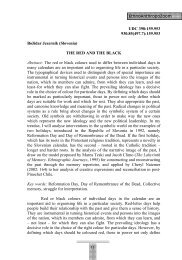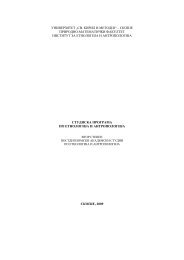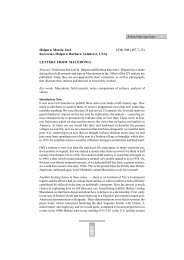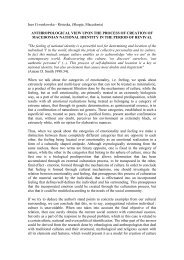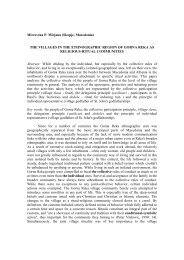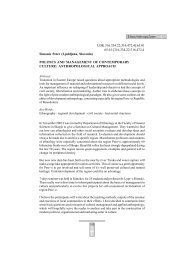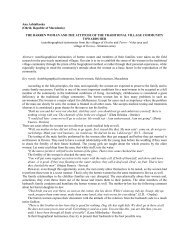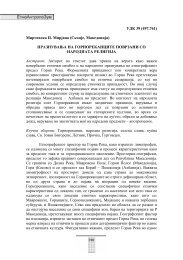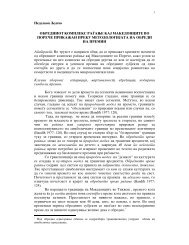Obrembski Jozef, Ritual and Social Structure in a Macedonian Village
Obrembski Jozef, Ritual and Social Structure in a Macedonian Village
Obrembski Jozef, Ritual and Social Structure in a Macedonian Village
You also want an ePaper? Increase the reach of your titles
YUMPU automatically turns print PDFs into web optimized ePapers that Google loves.
the holy periods ol the village's cere-<strong>in</strong>onial calendar <strong>and</strong> imposed on work, diet <strong>and</strong> other aspects<br />
of personal behavior. Violation of these prohibitions <strong>in</strong>curs supernatural sanctions, <strong>and</strong> these are<br />
particularly severe when more important sa<strong>in</strong>ts are <strong>in</strong>volved.<br />
Punishments are eventually <strong>in</strong>flicted not on the <strong>in</strong>dividual tresspassers, but on the whole village.<br />
Hence compliance with these norms is not a matter only of an <strong>in</strong>dividual's religious duty; it is, as<br />
well, his sacred duty to both the supernatural <strong>and</strong> his community <strong>and</strong> a matter of public concern.<br />
The sacred prohibitions constitute this part of ritual observances <strong>in</strong> which all without exception<br />
participate <strong>and</strong> with which everyone is expected to comply. This is considered essential for the<br />
welfare of the group <strong>and</strong> its cont<strong>in</strong>uity. Thus, <strong>in</strong> its operation the whole system of zar-otsi makes<br />
for an equation between the sacred <strong>and</strong> the social, the religious community <strong>and</strong> the village group.<br />
A tangible symbol of the religious dimension of tlie village is its church. No collective prayers or<br />
supplications are held <strong>in</strong> these t<strong>in</strong>y ljuild-<strong>in</strong>g. The local tradition does not provide for this form of<br />
religious expression. Nevertheless, together with the surround<strong>in</strong>g graveyard, the church area is the<br />
most important sacred space of the village, a center of its spiritual cohesion. Important, yearly rites,<br />
for <strong>in</strong>stance the Epiphany ritual (4) with its accompany<strong>in</strong>g feast<strong>in</strong>g <strong>and</strong> danc<strong>in</strong>g, are held there. The<br />
graveyard itself is an important place of ritual, the site of constantly recurr<strong>in</strong>g mortuary <strong>and</strong> postmortuary<br />
rites asaociated with a cult of the dead. The graveyard presents <strong>in</strong> a way a replica of the<br />
<strong>in</strong>ternal subdivisions of the village, with the location of the graves correspond<strong>in</strong>g to the village's<br />
l<strong>in</strong>eages, subl<strong>in</strong>eages <strong>and</strong> households.<br />
Organization of <strong>Ritual</strong> Activities<br />
There are several types of ritual activities: the celebration of the holy days <strong>and</strong> holy periods of the<br />
annual cycle; the cult of the dead; heal<strong>in</strong>g magic; div<strong>in</strong>ation; <strong>in</strong>dividual worship; crisis rites<br />
associated with the <strong>in</strong>dividual life cycle; <strong>in</strong>auguration <strong>and</strong> term<strong>in</strong>ation of ma<strong>in</strong> economic activities;<br />
weather magic; ritual curse <strong>and</strong> witchcraft.<br />
As <strong>in</strong> other villages of the region, there is no formal specialized <strong>and</strong> separate organization for<br />
tak<strong>in</strong>g care of the religious <strong>and</strong> ritual life of the local group. There is no village priesthood, no<br />
village ecclesia organized separately from the total life of the community, <strong>and</strong> no allocation of the<br />
ritual roles to only a few selected persons. <strong>Ritual</strong>, magico-religious, permeates deeply <strong>and</strong><br />
extensively all lunds of mundane activities <strong>and</strong> it is <strong>in</strong>tertw<strong>in</strong>ed with many phases of local culture.<br />
But ritually expressive religious behavior of the <strong>in</strong>dividual member of the group is not a matter of<br />
his personal religious commitment. Religious roles cannot be undertaken by the <strong>in</strong>dividual on a<br />
whim. They cannot he assumed by him because of his personal <strong>in</strong>cl<strong>in</strong>ations. They are assigned (5)<br />
to him, allocated by customary arrangements, accord<strong>in</strong>g to his social status: (he position he<br />
occupies <strong>in</strong> the village group as a man or a woman, a child or an adult, a neighbor, a k<strong>in</strong>sman or a<br />
family member.<br />
The allocation of ritual roles is neither haphazard nor does it depend upon the personality<br />
characteristics of the <strong>in</strong>dividual. It is related to the community's social structure <strong>and</strong> its status<br />
system. In spite of the seem<strong>in</strong>gly amorphous <strong>and</strong> diffused nature of religious behavior, there is a<br />
def<strong>in</strong>ite mesh<strong>in</strong>g of ritual roles with the social structure. One of the effects of the structural<br />
alignment of ritual roles is the emergence of various structurally determ<strong>in</strong>ed, sacerdotal group<strong>in</strong>gs,<br />
differently <strong>and</strong> differentially engaged <strong>in</strong> the performance of ritual activities. These ritual activities<br />
not only give expression to the religious sentiments of the performers <strong>and</strong> to the values shared <strong>in</strong><br />
common by the members of the village group, but they also articulate with file structural



